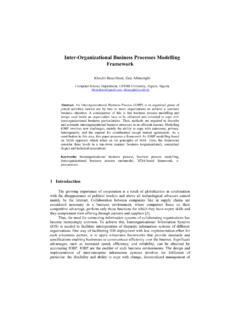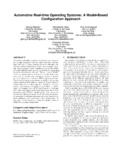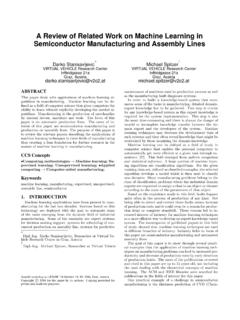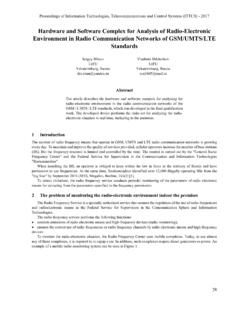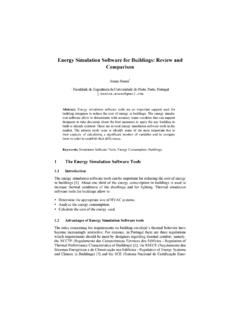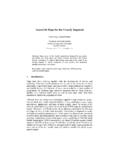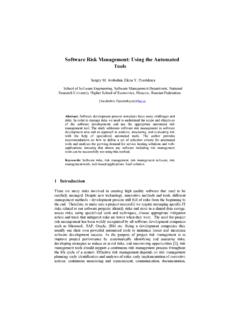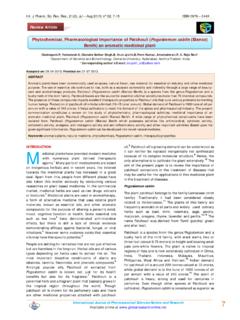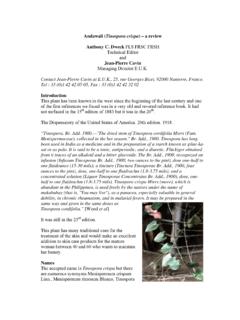Transcription of Bengali and Hindi to English Cross-language Text …
1 Bengali and Hindi to English Cross-languageText retrieval under limited ResourcesDebasis Mandal, Sandipan Dandapat, Mayank Gupta, Pratyush Banerjee, Sudeshna SarkarIIT Kharagpur, India{ , mayank, paper describes our experiment on two cross-lingual and one monolingualEnglish text retrievals at CLEF1in the ad-hoc track. The Cross-language task includesthe retrieval of English documents in response to queries in two most widely spokenIndian languages, Hindi and Bengali . For our experiment, we had access to a Hindi - English bilingual lexicon, Shabdanjali , consisting of approx. 26K Hindi words. Butneither we had any effective Bengali - English bilingual lexicon nor any parallel corporato build the statistical lexicon.}
2 under this limited resources, we mostly depended onourphoneme-based transliterations to generate equivalent English query from Hindi andBengali topics. We adopted Automatic Query Generation and Machine Translationapproach for our experiment. Other language -specific resources included a Bengalimorphological analyzer, a Hindi stemmer and a set of 200 Hindi and 273 Bengali stop-words. Lucene framework was used for stemming, indexing, retrieval and scoring ofthecorpus documents. The CLEF results suggested the need for a rich bilingual lexiconfor CLIR involving Indian languages. The best MAP values for Bengali , Hindi andEnglish queries for our experiment were , and and Subject [Information Storage and retrieval ]: Content Analysis and Indexing; In-formation Search and retrieval ; Systems and Software; Digital Libraries.
3 ; [Database Management]: Languages Query LanguagesGeneral TermsMeasurement, Performance, , Hindi , Transliteration, Cross-language Text retrieval , CLEF IntroductionCross- language (or cross-lingual) Information retrieval (CLIR) involves the study of retrievingthe documents in a language other than the query language . Since the language of query anddocuments to be retrieved are different, either the documents or queries need to be translatedin CLIR. But this translation step tends to cause a reduction in the retrieval performance of1 Cross language Evaluation Forum. as compared to monolingual information retrieval . A study in [1] showed that missingspecialized vocabulary, missing general terms, wrong translation due to ambiguity and correctidentical translation are the four most important factors for the difference in performance forover 70% queries between monolingual and cross-lingual retrievals.
4 This puts the importance oneffective translation in CLIR research. Again, the document translation requires a lot of memoryand processing capacity than its counterpart and therefore the query translation ismore popularin the IR research community involving multiple languages[5].Oard [7] presents an overview of the Controlled Vocabulary and Free Text retrieval approachesfollowed in CLIR research within the query translation framework. But the present research inCLIR are mainly concentrated around three approaches: Dictionary based Machine Translation(MT), Parallel Corpora based statistical lexicon and Ontology-based methods. The basic idea inMachine Translation is to replace each term in the query with an appropriate term or a set ofterms from the lexicon.
5 In current MT systems the quality of translations isvery low and the highquality is achieved only when the application is domain-specific [5]. The ParallelCorpora-basedmethod utilizes the broad repository of multi-lingual corpora to build the statistical lexicon fromthe simliar training data as of the target collection. Knowledge-based approaches useontology orthesauri to replace the source language word by all of its target language equivalents. Some of theCLIR models built on these approaches or on their hybrids can be found in [5][6][8][10].This paper presents two cross-lingual and one English monolingual text retrieval . The Cross-language task includes English document retrieval in response to queries in two Indian languages: Hindi and Bengali .
6 Although Hindi is mostly spoken in north India and Bengali inthe EasternIndia and Bangladesh only, the former is the fifth most widely spoken language inthe world andBengali the seventh. This requires attention on CLIR involving these languages. In this paper,we restrict ourselves to Cross-language text retrieval applying Machine Translation rest of the paper is structured as follows. Section 2 briefly presents some of theworkson CLIR involving Indian languages. The next section provides the language specificand opensource resources used for our experiment. Section 4 builds our CLIR model on the resources andexplains our approach. CLEF evaluations of our results and their discussions are presented in thesubsequent section.
7 We conclude this paper with a set of inferences and scope of future Related WorkCross- language retrieval is a budding field in India and the works are still in its primitive first major work involving Hindi occurred during TIDES Surprise language exercise in aone month period. The objective of the exercise was to retrieve Hindi documents, provided byLDC (Linguistic Data Consortium), in response to English queries. The participants used parallelcorpora based approach to build the statistical lexicon [3][4][12]. [4]assigned statistical weightageon query and expansion terms using the training corpora and this improved their cross-lingualresults over monolingual runs. [3][9] indicated some of the language -specific obstacles for Indianlanguages, viz.
8 , propritary encodings of much of the web text, lack of availability of parallelcorpora, variability in Unicode encoding etc. But all of these works were the reverse of ourproblem statement for CLEF. The related work of Hindi - English retrieval can be found in [2].3 Resources usedWe used various language specific resources and open source tools for our Cross language Info-mation retrieval (CLIR) experiments. For the processing of English query and corpus, we usedthe stop-word list (33 words) and porter stemmer of Lucene framework. For Bengali query, aBengali- English transliteration (ITRANS) tool2[11], a set of Bengali stop-words3(273 words),2 ITRANS is an encoding standared specifically for Indian languages.
9 It converts the Indian language letters intoRoman ( English ) mostly using its phoneme list was provided by Jadavpur University, open source Bengali - English bio-chemical lexicon ( 9k Bengali words) and a Bengali morpho-logical analyzer of moderate performance were used. Hindi language specific resources includeda Hindi - English Transliteration tool (wx and ITRANS), a Hindi stop-word list of 200 words, aHindi- English bilingual lexicon Shabdanjali containing approximately 26K Hindi words and aHindi Stemmer4. We also manually built a named entity list of 1510 entries mainly drawn fromthe names of countries and cities, abbreviations, companies, medical terms, rivers,seven wonders,global awards, tourist spots, diseases, events of 2002 from wiki etc.
10 Finally, the open source Luceneframework was used for indexing and retrieval of the documents with their corresponding Experimental ModelThe objective of Ad-Hoc Bilingual (X2EN) and Monolingual English tasks was to retrieve therelevant documents from English target collection and submit the results in ranked order. Thetopic sets for these two tasks consist of 50 topics and the participant is asked to retrieve at least1000 documents from the corpus per query for each of the source languages. Each topic consistsof three fields: a brief title , almost equivalent to a query provided by the end-user toa searchengine; a one-sentence description , specifying more accurately what kind of documents the user islooking for from the search and a narrative for relevance judgements, describing what is relevantto the the topic and what is not.
